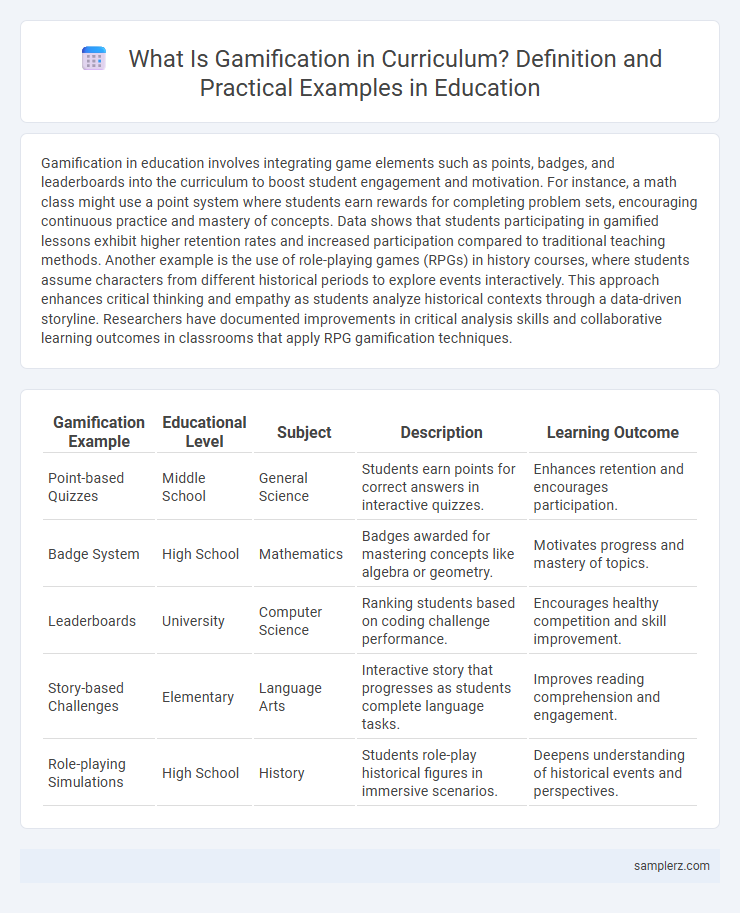Gamification in education involves integrating game elements such as points, badges, and leaderboards into the curriculum to boost student engagement and motivation. For instance, a math class might use a point system where students earn rewards for completing problem sets, encouraging continuous practice and mastery of concepts. Data shows that students participating in gamified lessons exhibit higher retention rates and increased participation compared to traditional teaching methods. Another example is the use of role-playing games (RPGs) in history courses, where students assume characters from different historical periods to explore events interactively. This approach enhances critical thinking and empathy as students analyze historical contexts through a data-driven storyline. Researchers have documented improvements in critical analysis skills and collaborative learning outcomes in classrooms that apply RPG gamification techniques.
Table of Comparison
| Gamification Example | Educational Level | Subject | Description | Learning Outcome |
|---|---|---|---|---|
| Point-based Quizzes | Middle School | General Science | Students earn points for correct answers in interactive quizzes. | Enhances retention and encourages participation. |
| Badge System | High School | Mathematics | Badges awarded for mastering concepts like algebra or geometry. | Motivates progress and mastery of topics. |
| Leaderboards | University | Computer Science | Ranking students based on coding challenge performance. | Encourages healthy competition and skill improvement. |
| Story-based Challenges | Elementary | Language Arts | Interactive story that progresses as students complete language tasks. | Improves reading comprehension and engagement. |
| Role-playing Simulations | High School | History | Students role-play historical figures in immersive scenarios. | Deepens understanding of historical events and perspectives. |
Integrating Game-Based Assessments in Classrooms
Integrating game-based assessments in classrooms enhances student engagement by providing interactive and adaptive evaluation methods aligned with learning objectives. These assessments utilize real-time feedback and data analytics to tailor instruction, improving comprehension and retention in subjects like mathematics and science. Educational platforms incorporating gamified quizzes and simulations promote critical thinking and motivation, facilitating a more personalized and effective learning experience.
Reward Systems to Motivate Student Participation
Integrating reward systems in gamification enhances student participation by offering points, badges, or leaderboards that recognize achievements and encourage continuous engagement. These tangible incentives boost motivation and create a competitive yet collaborative learning environment, promoting active involvement in educational activities. Research indicates that well-designed reward systems improve retention and foster positive behavioral changes in students.
Leveling Up: Progression Mechanics in Course Design
Leveling up through progression mechanics in course design enhances student engagement by providing clear milestones and rewards for skill mastery. Incorporating tiered challenges and unlockable content motivates learners to advance, mirroring video game dynamics that promote sustained effort. This approach improves knowledge retention and fosters a growth mindset by emphasizing incremental achievement and continuous improvement.
Digital Badges and Achievements in Learning Modules
Digital badges in education serve as visual representations of student achievements within learning modules, enhancing motivation through clear recognition of skills acquired. These badges are integrated into curriculum frameworks to track progress, encourage mastery of specific competencies, and provide shareable credentials for resumes or portfolios. By embedding achievement systems in digital platforms, educators create interactive and gamified experiences that promote active engagement and sustained learning outcomes.
Leaderboards to Encourage Friendly Competition
Leaderboards in educational gamification promote engagement by showcasing student progress and achievements in real-time, fostering a sense of friendly competition. This system motivates learners to improve their performance by comparing scores, completion rates, and mastery levels in subjects like math, science, and language arts. Incorporating leaderboards into curricula enhances motivation, participation, and goal-setting, ultimately boosting academic outcomes through interactive learning experiences.
Storytelling and Narrative Structures in Curriculum
Storytelling and narrative structures enhance student engagement and comprehension by integrating gamification elements such as interactive story arcs, character-driven quests, and decision-based outcomes. Educators design curricula where learners progress through multimedia narratives, solving puzzles and completing challenges that reinforce subject concepts. This approach fosters critical thinking, creativity, and retention by making abstract ideas tangible within immersive educational games.
Educational Quests and Missions for Deeper Engagement
Educational quests and missions incorporate game mechanics like challenges, rewards, and storylines into the curriculum to boost student motivation and engagement. By assigning tasks that require problem-solving and collaboration, these methods enhance critical thinking and foster active learning. Research shows that gamified learning environments increase retention rates and encourage deeper cognitive processing compared to traditional instruction.
Personalized Learning Paths Through Gamified Elements
Personalized learning paths through gamified elements transform traditional education by adapting challenges and content to individual student needs, preferences, and skill levels. Utilizing adaptive quizzes, badges, and progress bars, these gamification strategies enhance engagement and motivation while providing real-time feedback tailored to each learner's pace. This approach improves knowledge retention and fosters a growth mindset by encouraging students to set achievable goals and celebrate their unique educational milestones.
Collaborative Problem-Solving in Game-Inspired Projects
Game-inspired projects in education enhance collaborative problem-solving by engaging students in interactive scenarios that mimic real-world challenges. Incorporating tools like digital escape rooms and multiplayer strategy games fosters teamwork, critical thinking, and communication skills among students. Research shows that gamified curricula improve participation and knowledge retention, making learning more dynamic and effective.
Real-World Scenarios Simulated Through Gamification
Simulating real-world scenarios through gamification in education enhances student engagement and practical skills by integrating industry-specific challenges into the curriculum. For instance, business courses use virtual stock market games to teach financial decision-making, while medical programs incorporate interactive patient diagnosis simulations to develop clinical reasoning. These immersive experiences bridge theoretical knowledge and real-life application, fostering deeper understanding and retention.

example of Gamification in curriculum Infographic
 samplerz.com
samplerz.com